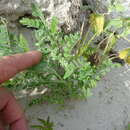Comments
(
Inglês
)
fornecido por eFloras
Though the exact localities and habitats are not known in all cases, but whenever this information is available, it has substantiated in almost all cases that it is a plant of saline meadows, river valleys or grows in the vicinity of lakes. There is strong evidence to support the hypothesis that the migratory birds disseminate the seeds. This also explains the rather abnormal distributional pattern of this taxon.
- licença
- cc-by-nc-sa-3.0
- direitos autorais
- Missouri Botanical Garden, 4344 Shaw Boulevard, St. Louis, MO, 63110 USA
Description
(
Inglês
)
fornecido por eFloras
Annual, suberect or procumbent, c. 5-45 cm tall, stem branched from the base, pubescent, hairs soft, white, spreading. Leaves imparipinnately compound, c. 5-15 cm long, petiole and rachis pubescent; leaflets 13-21, c. 5-12 mm long, oblanceolate, elliptic or oblong, entire, retuse, densely pilose on both sides; stipules c. 5-6 mm long, partially adnate to the base of the petiole, pubescent, hairs white. Inflorescence an axillary, peduncled raceme, peduncle c. 1-7.5 cm long, pubescent. Bracts c. 2.5-3 mm long, white-ciliate. Flowers subsessile. Calyx c. 5-6 mm long, densely pubescent, hairs white and black, teeth c. 2.5-4 mm long. Corolla yellow. Vexillum c. 5.5-6.5 mm long. Wing c. 4.5-5 mm long. Keel c. 5.5 mm long. Fruit subsessile, c. 1-2.2 cm long, falcate or spirally twisted, crumpled-rugose, pubescent, hairs white, semibilocular; seeds 20-30.
- licença
- cc-by-nc-sa-3.0
- direitos autorais
- Missouri Botanical Garden, 4344 Shaw Boulevard, St. Louis, MO, 63110 USA
Distribution
(
Inglês
)
fornecido por eFloras
Distribution: Central Europe, Russia; European Russia, Caucasus, Eastern Siberia, Central Asia, Pakistan (Punjab, Sind, Baluchistan).
- licença
- cc-by-nc-sa-3.0
- direitos autorais
- Missouri Botanical Garden, 4344 Shaw Boulevard, St. Louis, MO, 63110 USA
Flower/Fruit
(
Inglês
)
fornecido por eFloras
Fl.Per.: April-July.
- licença
- cc-by-nc-sa-3.0
- direitos autorais
- Missouri Botanical Garden, 4344 Shaw Boulevard, St. Louis, MO, 63110 USA
Comprehensive Description
(
Inglês
)
fornecido por North American Flora
Contortuplicata contortuplicata (L.) Rydberg
Astragalus contortuplicatus L. Sp. PI. 758. 1873.
Contortuplicata astragaloides Med. Vorl. Churph. Phys. Ges. 2: 378. 1787.
Annual; stem branched from the root; branches erect, ascending or decumbent, 1-3 dm. long, pilose; leaves 7-12 cm. long, spreading; stipules ovate, 3-4 mm. long; leaflets 15-21, cuneate, ovate or oval in outline, usually deeply notched at the apex, 7-20 mm. long, pilose on both sides; peduncles 1-2 cm. long; racemes very short and head-like, 1-2 cm. long; calyx long-pilose, the tube 2 mm. long, the teeth subulate, 2-2.5 mm. long; corolla white or yellowish, 5 mm. long; banner obovate, retuse; wings a little shorter, the blade broadly lunate, rounded at the apex, with a deltoid retrorse auricle; keel-petals similar but longer and broader; pod membranous, pilose, sessile, strongly falcate, forming a complete circle less than 1 cm. in diameter, the body 2-2.5 mm. wide.
Type locality: Siberia.
Distribution: Native of the Old World from Southeastern Europe to Siberia, western India, and Egypt; adventive at Westport, Massachusetts.
- citação bibliográfica
- Per Axel Rydberg. 1919. (ROSALES); FABACEAE; PSORALEAE. North American flora. vol 24(1). New York Botanical Garden, New York, NY
Physical Description
(
Inglês
)
fornecido por USDA PLANTS text
Annual, Herbs, Taproot present, Nodules present, Stems or branches arching, spreading or decumbent, Stems less than 1 m tall, Stems solid, Stems or young twigs sparsely to densely hairy, Stem hairs hispid to villous, Leaves alternate, Leaves petiolate, Stipules conspicuous, Stipules green, triangulate to lanceolate or foliaceous, Stipules membranous or chartaceous, Stipules persistent, Stipules free, Leaves compound, Leaves odd pinnate, Leaf or leaflet margins entire, Leaflets opposite, Leaflets 10-many, Leaves hairy on one or both surfaces, Inflorescences racemes, Inflorescences globose heads, capitate or subcapitate, Inflorescence axillary, Bracts very small, absent or caducous, Flowers zygomorphic, Calyx 5-lobed, Calyx hairy, Petals separ ate, Corolla papilionaceous, Petals clawed, Petals white, Petals ochroleucous, cream colored, Banner petal narrow or oblanceolate, Wing petals narrow, oblanceolate to oblong, Wing tips obtuse or rounded, Keel petals auriculate, spurred, or gibbous, Keel tips obtuse or rounded, not beaked, Stamens 9-10, Stamens diadelphous, 9 united, 1 free, Filaments glabrous, Style terete, Style persistent in fruit, Fruit a legume, Fruit tardily or weakly dehiscent, Fruit elongate, straight, Fruit oblong or ellipsoidal, Fruit exserted from calyx, Fruit beaked, Fruit hairy, Fruit 11-many seeded, Seeds cordiform, mit-shaped, notched at one end, Seed surface smooth, Seeds olive, brown, or black.

